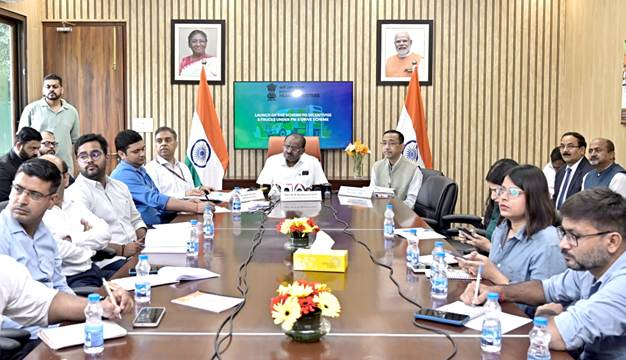HD Kumaraswamy Launches First-Ever Incentive Scheme for e-Trucks Under PM E-DRIVE
Steel Authority of India Limited (SAIL) has set a precedent by committing to procure 150 e-trucks over the next two years, to be deployed across its facilities nationwide.

- Country:
- India
In a historic move to revolutionize freight mobility and advance India’s climate goals, the Ministry of Heavy Industries (MHI) has launched a landmark scheme under the PM E-DRIVE initiative to offer direct financial incentives for electric trucks (e-trucks). Spearheaded by Prime Minister Narendra Modi and steered by Union Minister for Heavy Industries & Steel, Shri H.D. Kumaraswamy, this initiative marks India’s first-ever dedicated policy support for electric trucks, ushering in a new era of sustainable, clean, and efficient freight transportation.
A Milestone for Green Freight Mobility
The scheme recognizes the outsized environmental impact of diesel trucks, which, despite accounting for just 3% of India’s vehicle population, contribute to a staggering 42% of transport-related greenhouse gas (GHG) emissions. By incentivizing the adoption of electric trucks, the government is taking decisive action to curb air pollution, reduce carbon emissions, and lower logistics costs, while also supporting India’s vision of Viksit Bharat by 2047 and its commitment to net-zero emissions by 2070.
Shri H.D. Kumaraswamy emphasized the transformative nature of the scheme, stating:
“This pioneering scheme, guided by the visionary leadership of Prime Minister Shri Narendra Modi, will drive our nation toward sustainable freight mobility and a cleaner future.”
Incentives and Coverage Details
The new scheme offers demand incentives for N2 and N3 category electric trucks, as defined under the Central Motor Vehicle Rules (CMVR):
-
N2 Category: Trucks with a Gross Vehicle Weight (GVW) above 3.5 tonnes up to 12 tonnes.
-
N3 Category: Trucks with GVW exceeding 12 tonnes and up to 55 tonnes. For articulated vehicles, incentives apply only to the puller tractor unit of the N3 category.
Warranty Requirements
To guarantee vehicle performance and reliability, strict manufacturer-backed warranties are mandated:
-
Battery: 5 years or 5 lakh km, whichever comes first.
-
Vehicle & Motor: 5 years or 2.5 lakh km, whichever comes first.
Incentive Structure
The incentive amount is based on the GVW of the e-truck, with a maximum incentive of ₹9.6 lakh per vehicle. It will be provided as an upfront discount on the purchase price and reimbursed to OEMs via the PM E-DRIVE portal on a first-come, first-served basis.
The scheme aims to support the deployment of approximately 5,600 e-trucks across India. In a special regional focus, Delhi has been allotted 1,100 e-truck incentives, backed by a dedicated outlay of ₹100 crore, reflecting the government’s commitment to addressing the capital’s severe air pollution crisis.
Sectoral and Industrial Impact
The scheme is expected to catalyze e-truck adoption in sectors such as:
-
Cement and construction
-
Ports and shipping
-
Steel and heavy industries
-
Logistics and warehousing
Major OEMs like Volvo Eicher, Tata Motors, and Ashok Leyland are already manufacturing electric trucks in India, bolstering the Atmanirbhar Bharat (self-reliant India) agenda through indigenous development and production.
Strong Commitment from Public Sector Enterprises
Steel Authority of India Limited (SAIL) has set a precedent by committing to procure 150 e-trucks over the next two years, to be deployed across its facilities nationwide. SAIL also announced a new internal policy mandating that at least 15% of vehicles hired across its operations will be electric — highlighting a broader CPSE-led push for clean mobility.
Mandatory Scrappage of Old Trucks
To qualify for incentives, beneficiaries must scrap old, polluting diesel trucks, a move that not only accelerates fleet modernization but also reinforces air quality improvements by removing the most emission-intensive vehicles from Indian roads.
Enabling a Low-Carbon, High-Efficiency Logistics Future
The PM E-DRIVE e-truck initiative addresses key barriers to electric truck adoption — namely high upfront costs and range concerns — by providing fiscal support and performance guarantees. It aims to:
-
Lower long-term Total Cost of Ownership (TCO) for fleet operators
-
Drive clean energy adoption in heavy-duty transport
-
Improve urban air quality and reduce industrial emissions
-
Position India as a leader in sustainable logistics solutions
The scheme has already generated strong interest from OEMs, fleet operators, and state governments, all of whom see it as a long-awaited policy signal that India is serious about transforming its freight sector.
The launch of India’s first e-truck incentive scheme under PM E-DRIVE is a defining policy shift towards a greener, cleaner, and more cost-efficient freight transport model. It demonstrates the government's strategic vision and policy clarity in nurturing the electric vehicle ecosystem — not just for passenger cars but for the vital backbone of India’s supply chains: trucks.
As India strives toward a carbon-neutral economy, this pioneering initiative represents a bold, impactful step forward — aligning sustainable mobility with industrial growth and environmental responsibility.
ALSO READ
BCCL Revives PB Project, Launches CIL’s First MDO Coal Mine for Atmanirbhar Bharat
Nistar Sets Sail: India's First Indigenous Deep-Sea Diving Vessel Delivered to Navy
Admiral's Cup Returns: A Global Sailing Showdown
Harnessing Solar Sails: A New Frontier in Space Weather Prediction
Sailing Towards Unity: BIMSTEC Ports Conclave to Set Sail










